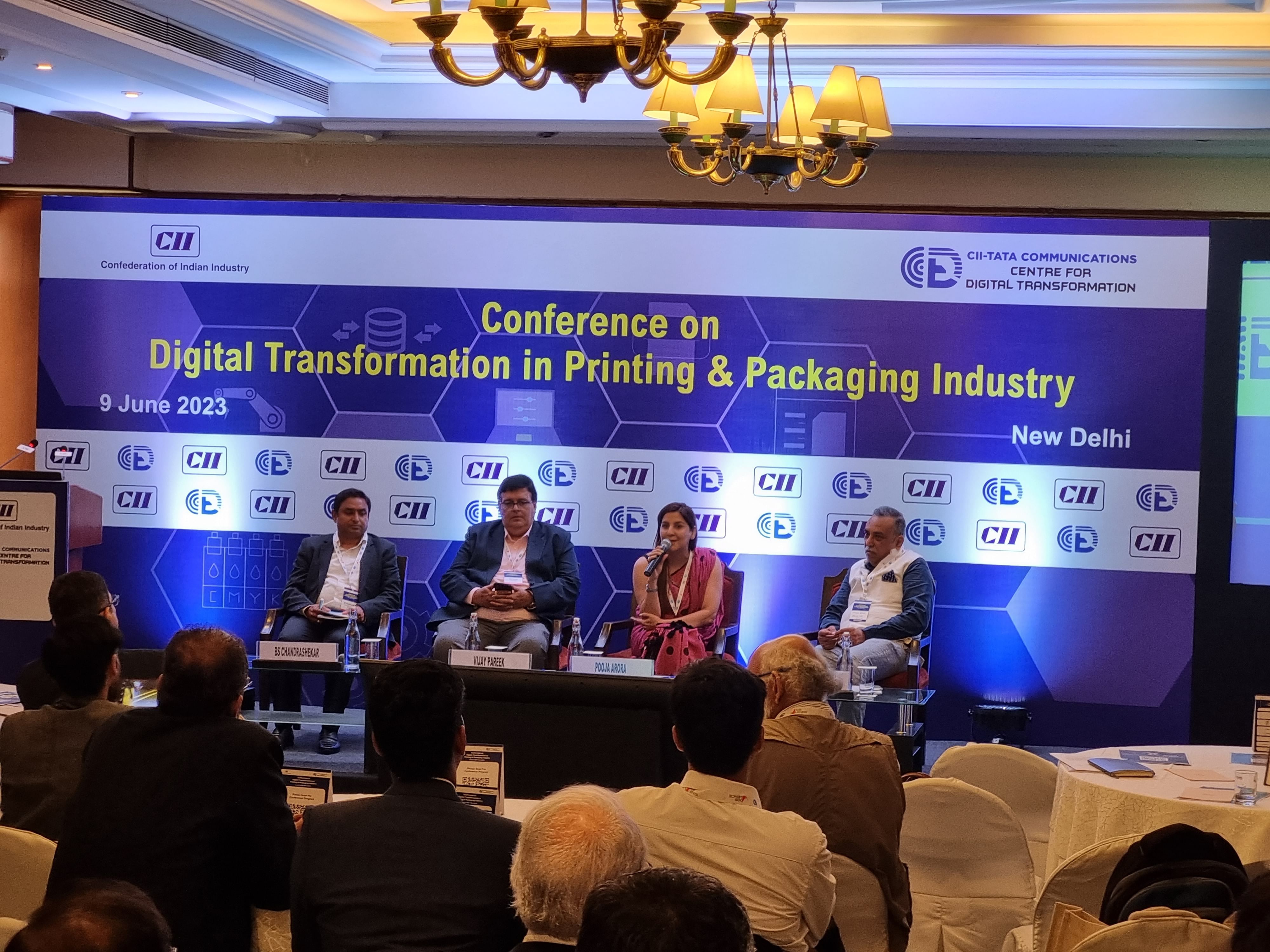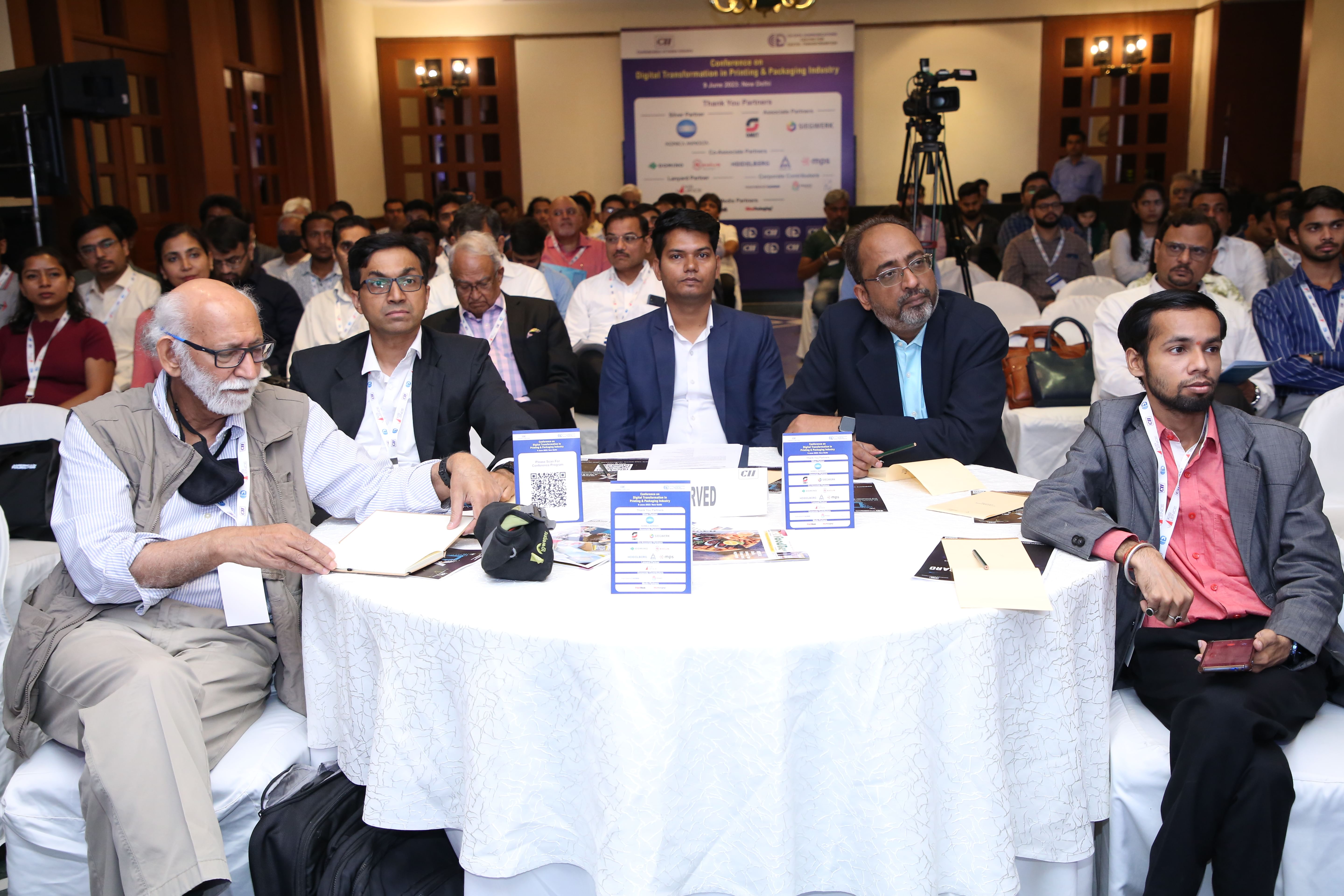CII conference discusses the challenges of digital transformation
With the recent developments in generative AI, it is high time the industry started working towards integrating digital within the company setup, from workflow management to supply chain management. This also aligns with the government’s mandate towards a digital India. To bring home the point, CII and the Tata Communications Centre for Digital Transformation hosted a conference on digital transformation in the printing and packaging industry on 9 June 2023.
13 Jun 2023 | By Dibyajyoti Sarma
The conference showcased the latest technological trends in printing and packaging, focusing on automation, safety, digital printing, and consumer-connected packaging. This included navigating the printing and packaging industry: digital transformation, challenges, and opportunities: folding cartons, flexibles, labels, corrugation and packing, and filling lines.
In the industry, we usually associate digital with printing technology. However, in the true sense, digital, as opposed to analogue, is much bigger and includes everything from AI and cloud to sensors to the Internet of Things to printing electronics to robotics. Technology is already there and it is constantly evolving. What it needs is focused implementation.
Challenges and opportunity
Speaking in the inaugural session, Abhik Tandon of McKinsey and Company said that digital transformation can be achieved with flexible, automation, AI-based visual inspection, digital performance management, using AI for product development, and so on. He gave an example of how the AI imaging tool, Midjourney, has helped design yoghurt tubs for a brand. “It improves the lead time in the product’s journey from conception to the market,” he said.
Tandon said while technology is available and 90% of CEOs believe that digital will have an impact in the future, only 23% of them are sponsoring digital initiatives.
Costing is a major concern. Plus, there is not enough skilled manpower to handle such projects.
Tandon said that businesses need to take an integrated approach to digital transformation. It’s a long-term investment, and once it starts working the ROI will be visible in terms of faster turnaround and capacity building.
For this, he said, businesses need to think big and create full transparency in digital transformation.
We have now moved beyond Industry 4.0 to Industry 5.0, which includes AI-powered robots. The technology is available. It's time for organisations to get into the mindset of utilising technology.
Dr Babu Rao Guduri of Indian Institute of Packaging (IIP) said that digital transformation involves business model transformation. He added that while digital will help sustainability, it will not be an overtime transformation. It will take time.
As the focus shifted towards AI, an audience member rightly pointed out we seem to be jumping ahead to AI, from basic analogue manufacturing, thereby missing several crucial steps in between. True, the technology is ready, and most print businesses have also invested in basic digital technology, but are they already using the advantages of the technology they already have to its full potential? Most print businesses in India still work in the traditional way and do not have enough skilled personnel who can help take advantage of the technologies available.
So, a business might invest in smart sensors for quality control in the assembly line, but who will make sure that the sensors are working to their full potential?
The question is how to change the mindset.
Tandon said that businesses need to hire people with the right kind of skillset and also offer the right kind of training to their employees. Technology is changing constantly, so businesses will need a digital management team to keep up with the changes.
Cost is also a concern. However, Tandon argued that the cost has come down significantly.
SN Ventataraman, conference chairman and chief executive, packaging and printing business, ITC, said one of the reasons why the industry is resistant towards investing in digital transformation is that we do not have a role model in India who can demonstrate a success story.
He said it’s a slow process and it will take time, and one of the main reasons for this is the lack of skilled manpower.
The conference brought together senior representatives from FMCG companies, printing and packaging, technology providers, and related companies
Digital transformation of EPR
The second session focused on the concept of Extended Producer Responsibility (EPR) and how it has evolved with digital transformation. Introducing the topic, Ventataraman said that the initiative has been a success and its digital backbone is working.
EPR is a compliance mandate which states that the producer of a product is responsible for picking up the waste generated by that product. It was mandated via Plastic Waste Management Rules.
EPR programmes aim to reduce waste and promote environmentally responsible behaviour from manufacturers and consumers. With the rise of eCommerce, the amount of packaging waste has increased significantly, and EPR programmes have been adopted by incorporating digital tools and technology.
Abhishek Garg of AA Garg and Co explains how the entire EPR process is managed through a centralise portal. The manufacturers and brand owners earn online credits through the portal as credits can be added only by the registered waste processors.
There are four entities that need to register in the portal – producers, importers, brand owners and waste processors. Registration on the online portal is a must for everyone, except for micro brand owners.
In short, the portal tracks the details of the transactional value chain. It’s a one-stop system.
According to the Central Pollution Control Board (CPCB) data, around 2,000 plastic-based processors are registered in the portal. Among them, the majority are recyclers. The registration is completed after CPCB conducts a physical verification.
The system became fully functional on 6 January 2023.
Sunil Panwar of Symphony Environmental India, however, pointed out some of the drawbacks of why the registration has been significantly low. One of the reasons, he said, is the amount of paperwork that needs to be uploaded. Thus, most businesses outsource the task. Another worry is data security, as the business needs to share confidential data.
Panwar wondered if there is a way to simplify the process.
Also, in India, a lot of plastic materials are processed through traders, but there is no provision for traders to register themselves in the portal. So, there is no way to track and trace these materials.
At the recycling level, Panwar said, quality control is needed during the recycling process to get quality recycled products. Often, the recycling process uses mixed materials, which results in low-quality products.
The third session of the conference focused on digital opportunities in customer service, supply chain and operations.
The session focused on the digital opportunities available in customer service, supply chain, and operations in printing and packaging. With the advancement in technology, businesses in the industry can leverage digital solutions to streamline their operations, enhance their supply chain efficiency and improve their customers' service experience.

We have now moved beyond Industry 4.0 to Industry 5.0, which includes AI-powered robots
The speakers agreed that machine-learning devices are helping the industry. With automation in place, it’s possible to produce more in less time. But it will not replace human employees anytime soon. Human intervention is part of the process.
Vijay Pareek of Genius Flexo explained how RFID has now become a sales tool, where one a find the location of a particular product in a warehouse or in a shop with a quick scan.
He said businesses need to embrace digital as a long-time goal and integrate it with their existing setup.
Nagesh Bakshi of Bakshi Mark said the QR code is a good digital innovation, which can help the supply chain process.
He added that for digital transformation of the supply chain to work, you have to make the entire system digital and every stakeholder in the supply chain needs to play their part.
Regarding automation on the shopfloor, BS Chandrashekar of Heidelberg said according to its case studies the use of digital has improved machine efficiency by 30-56%.
The fourth session of the conference was on implementing automation on the shopfloor.
The session focused on how automation can bring significant benefits to business, including increased productivity, reduced errors, and improved quality control. However, implementing automation can also be a complex process that requires careful planning and execution.
Thus, businesses need a benchmark monitor which can track the changes. Also, it must be collaborative automation, where man and machine work together.
The final session of the day was on enhancing consumer experience through digital printing and smart packaging.
The session explored how digital adoption can enhance customer experience. As the work becomes increasingly digital, customers expect a seamless experience across all touchpoints. By leveraging digital technologies, companies can create a personalised and engaging experience that meets the need of their customers.



